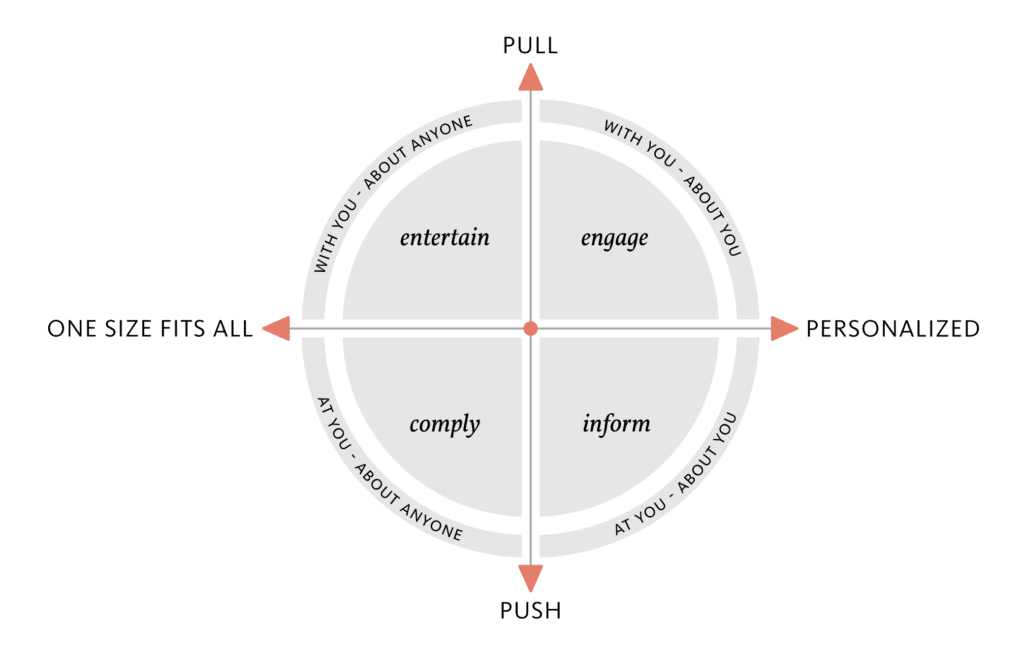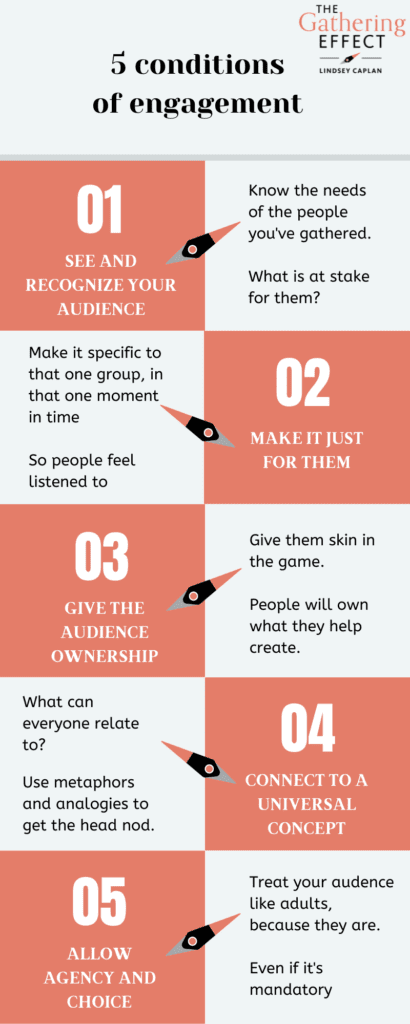A lot of time and money is focused on how to get employees to change, whether we want others to comply, be informed, entertained or engaged. Often our tool to communicate and spark this change is gatherings. We spend millions of dollars on virtual and in-person town halls, all-hands, off-sites, leadership classes, conferences and new hire orientations. Yet few gatherings produce the long-term effect we desire and the change we’re seeking for our employees doesn’t stick.
Julia, the CEO of a global healthcare company, had noticed a concerning pattern in her organization. Employees were reluctant to speak up or provide constructive feedback. Without the ability to voice concerns or help others improve, she worried about the effects on innovation and learning. So Julia called a leading expert on feedback and invited him to speak at her company’s monthly all-hands. If everyone heard the same message at the same time they would start to act accordingly, she figured.
Later that month at the virtual all-hands, the expert was greeted by a sea of hundreds of smiling Zoom faces and generous applause. For 45 minutes, he shared his story and slides and engaged in an extended Q&A. Julia was hopeful and excited about the impact of the event.
In the days that followed, employees chatted about the town hall in messaging systems and meetings as copies of the expert’s book adorned every desk. Additional book orders were even placed to keep up with demand.
Julia was pleased. But not even two months later, Julia changed her tune. No one seemed to mention the talk or reference the model much anymore. Books still adorned desks but they sat like fossils, admired but not touched. She privately shared her disappointment with her executive team. Why had the problems she identified still existed, she wondered? “Our employees seemed to enjoy the event, but they aren’t changing – what’s missing?”
The apathetic response affected her that much more. It was personal. Why hadn’t her idea taken hold or been taken up by her own company? Julia’s story isn’t unique. To facilitate change or spark movement in others, we often rely on what seems to be the most efficient means to reach many people at once – a gathering.
I define gatherings as bringing people together to match a message with a moment. They can be the most powerful form of not only communication but connection. But when we gather in a room, whether virtual or in-person, we don’t always maximize this.
We pull people together only to have our efforts fall flat. We invest money and then wonder why the change didn’t stick. Subsequently, few of these gatherings go beyond the short-term impact to create real change or commitment.
What would take gatherings like these from simply ticking the box to truly transformational? To evaluate the success of our change efforts, we can start by looking at how we gather. I created this “Gathering Effect model” to define, diagnose and adjust our gatherings for the effect we want.
When we think about the gatherings that we have all been a part of, they tend to fall on a spectrum from push to pull (control) and from one size fits all to personalized (uniqueness). For example, the all-hands where the new talent assessment model is rolled out (push) to all employees (one size fits all) feels different than the interactive workshop (pull) that helps leaders build career paths for their team members (personalized).
What do we need from the people we’re trying to affect? We can make different choices within the same gathering to produce dramatically different effects. You can apply the model in two ways. First, to design a gathering. Second, to assess how participants perceive it.
The way change is communicated determines people’s level of ownership and commitment. Often what seems “pull” and “personalized” to those leading the change is “push” and “one size fits all” to others. Therefore, many organizational change efforts, like Julia’s, often feel as though something is being done to us instead of with us. That’s where they fall short.
Pull and personalized gatherings are additive and multiplicative. They engage people not just in one moment in time but often, beyond. They do so by focusing less on the content they share and more on the conditions they create. Instead of insisting someone comply, these five conditions establish an atmosphere in which people want to participate.
See and recognize your audience
High on a stage in a dark theater, Julia’s gathering seemed too physically and figuratively removed from the needs of those she was addressing. Erase the distance by connecting the dots between what is at stake for Julia and what others are invested in.
Unless we understand others’ needs and motivations and can describe them in their own words, gatherings stall at the rational-only level. The difference between entertained and engaged outcomes is emotional involvement. This is the equivalent of a burning platform. With that emotion comes the increased ability to recall the gathering and store it in long-term memory.
Make it just for them
“So, we could have just emailed about this?”
Part of what makes change efforts successful is feeling as though it was made just for us, even if someone has done the same rehearsed talk hundreds of times. When we outsource a gathering, we typically seek to customize it with facts about our organization or culture, and a Q&A at the end.
People want to feel their experience is unique in time and place and that they have a special and necessary role to play in its success. We do this by listening to who is in the room, and, like a good comedian, matching the audience’s reaction. Personalized gatherings create a strong in-group through shared experience and vocabulary.
Give the audience ownership
Typical gatherings put the audience in the passenger seat, passively listening to content that was pre-determined without their input. People will own what they help to create. This involvement leads to commitment. Leave space in the gathering to invite people to digest what they heard and share it back in their own words. This can be done with a simple question or prompt, especially after a content-heavy section. This small change relinquishes control to employees and shifts them from passive consumers to active co-creators.
Connect to a universal concept
What is the universal truth everyone in the room can nod their heads about? Though one could assume we’ve gathered to hear them, master gatherers don’t start with their experience. They begin with our experience, so the audience can see themselves in the material. Here you’ll hear the words “you” or “we” and reliance on the Socratic method to figuratively reach into the audience.
Allow agency and choice
Julia’s town hall was mandatory. But even in a required setting, we can treat our employees like adults by giving them agency and choice and increasing their status. Typical gatherings highlight the power and status differences between leadership and employees. Rather than asking employees to engage in new behavior, Julia could have discussed her own leadership team’s commitment first. By showing her company how much she needed their help, employees would have understood their important role in this process, thus elevating their status and desire to participate.
When we are a part of a gathering that transforms us, it’s rarely because of the content alone. It’s how we connect to it. The role of a leader is not simply to create the content but the conditions for the change they seek to stick and extend beyond them. The combination of choices we make can fuel motivation, draw people in and pull on their desire to take up a change as their own. Success is not necessarily measured in an immediate reaction, but in their ongoing commitment to join you in the change you seek. If we gather well, this is only the start.


















